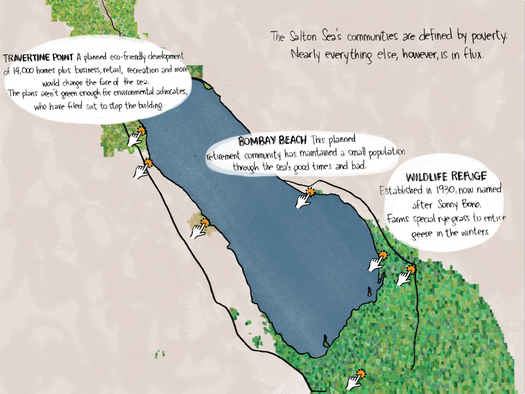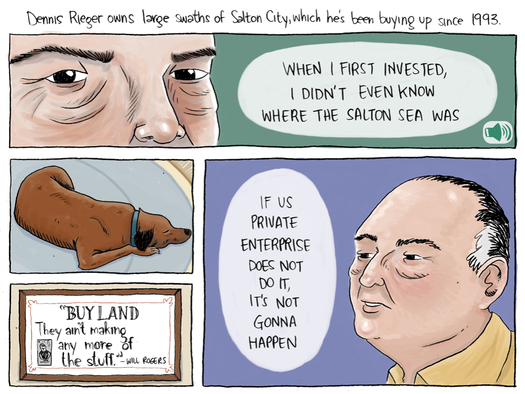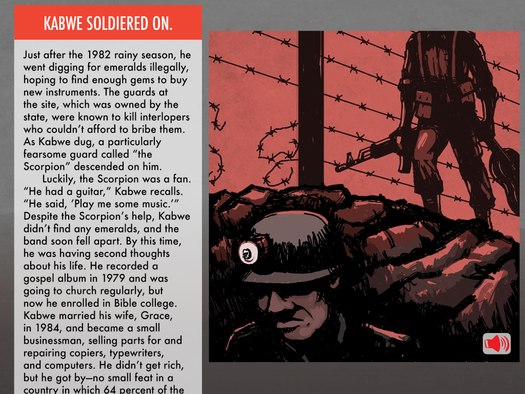Launched today, Symbolia is a digital publication devoted to nonfiction stories told in comics form — “the tablet magazine of illustrated journalism,” it’s calling itself. I’ve been anxiously awaiting its debut, and I am definitely not disappointed.
There’s quite a bit going on in nonfiction comics these days — and I don’t just mean memoirs and other first-person forms. Joshua Kramer’s The Cartoon Picayune, published in zine-like format, put out its fourth issue recently, with what looks to be another great lineup of journalistic comics. CartoonMovement.com publishes a steady stream of innovative and engaging nonfiction comics. There are too many book examples to mention (from journalism to true crime, philosophy to media analysis, with many, including recent titles from Joe Sacco and Josh Neufeld among others, coming from mainstream publishing houses). And there are plenty of interesting digital experiments, too — former Knight Fellow Dan Archer’s interactive comics come to mind, and so does this fantastic piece pairing recordings by Amy Standen with drawings by Wendy MacNaughton.
If you’re a comics fan you can probably give more examples. If you’re not, well, now’s your chance. Because my point is that Symbolia is arriving upon a creatively thriving visual/factual storytelling scene. And this is reflected in the first issue: There is a loose theme (“How We Survive”) but the five stories are extremely varied in both subject matter and approach — a perfect introduction to why this is a form of factual storytelling worth taking seriously.

Screen shot from "Sea Change," by Susie Cagle, from Symbolia.
Susie Cagle, known among other things for her coverage of Occupy Oakland, has an extensively researched eco-journalism piece about environmental threats to the Salton Sea in California. Cagle’s use of the add-ons that digital-ness makes possible are smart, extending what’s useful about comics as a form of nonfiction communication. She’s already quite good at balancing scenes with more data-centric forms like maps and charts, knowing when to show and what to tell. So it makes sense that for her story here, a map (for instance) is supplemented with touch-for-more-information buttons, and the handful of audio clips are used to add atmospheric richness (ambient field recordings, archival advertising) or reporting depth (interview snippets that help address one of the challenges of journalistic comics: concise text).

Screen shot from "Sea Change," by Susie Cagle, from Symbolia.
Meanwhile, a piece called “Ask Me About Psych Rock In Zambia" takes a different approach: only a few illustrations by Damien Scogin, with long chunks of text by Chris A. Smith, and audio of interview excerpts, plus some full-length songs to enjoy while you read.

Screen shot from "Ask Me About Psych Rock in Zambia," by Chris A. Smith and Damien Scogin, from Symbolia.
My favorite story is Sarah Glidden’s “The Rollerbladers of Sulaymaniyah,” which deploys no technical add-ons at all — for that matter, it’s in black and white — and would be just as effective in print. An account of a stint in Iraq, it’s informative, but in the human-scale way that comics can be so good at communicating. Glidden is an excellent visual storyteller, displaying the rare confidence in visual pacing that can make this such a rewarding and relatable form. 
Screen shot from "The Rollerbladers of Sulaymaniyah," by Sarah Glidden, from Symbolia.
So it’s a promising debut. The plan is to publish six themed issues a year (Symbolia’s principle form is an iPad app; I gather there is a PDF version that I have not looked at) for $2.99 each, or an annual $11.99 subscription. (See www.symboliamag.com for more.)
The challenge for Symbolia, I suspect, will be figuring out a way to break out to a wider audience. This issue should please the growing crowd that’s interested in this scene — but at this point I wonder if the number of practitioners isn’t growing even more quickly than that crowd. My hunch is that either the issue themes should become more tightly focused, or there should be a concerted effort to make sure all the stories have some sort of “timeless” payoff (in the style of, say, Radiolab). This actually plays to the strengths of comics as a nonfiction mode: it’s a form that takes time to create, and is suited to stories that aren’t “hot news” but rather are overlooked but important in enduring ways.
As a final note, I should mention that one subject area that so far as I know is mostly missing from the nonfiction comics movement is actually design — interesting, because it seems to me there should be good opportunities there. The most famous exception is almost certainly the Bjarke Ingels’ Yes Is More. But whatever the value of Ingels’ ideas, the book’s grasp of comics as medium is shaky at best, and it comes across as a very bloated portfolio that happens to include word balloons, more of a gimmick than a serious use of the form. (The best part of Yes Is More, in fact, is Ingels’ brief and energetic straight-text forward.) Another exception is Citizens of Noplace, by Jimenez Lai, billed as “an architectural graphic novel.” This has interesting ambitions, but is so impressionistic in its execution that I’d have to agree with the subtitle that’s it is closer to fiction than reality.
Maybe I’ve missed other exceptions; feel free to correct me. But meanwhile, maybe I’ll just hope that Symbolia comes up with a design issue. Because I’m subscribing.
